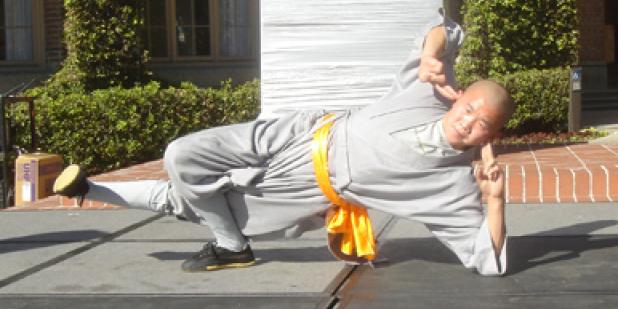Happy Lunar New Year from the USC US-China Institute!
Shaolin Temple and the 21st Century

By Kami Holman
 On November 20, 2006, the USC U.S. – China Institute, along with the USC East Asian Studies Center and the USC Center for Religion and Civic Culture, hosted a delegation of warrior monks from China's famed Shaolin Temple 少林寺. Peter Shiao, filmmaker and U.S. liaison for the temple, spoke on behalf of Abbot Shi Yongxin who was called back to Henan Province on short notice. Mr. Shiao spoke of the 1,500 year history of the temple, emphasizing its important role in cultural exchange.
On November 20, 2006, the USC U.S. – China Institute, along with the USC East Asian Studies Center and the USC Center for Religion and Civic Culture, hosted a delegation of warrior monks from China's famed Shaolin Temple 少林寺. Peter Shiao, filmmaker and U.S. liaison for the temple, spoke on behalf of Abbot Shi Yongxin who was called back to Henan Province on short notice. Mr. Shiao spoke of the 1,500 year history of the temple, emphasizing its important role in cultural exchange.
Shaolin Temple was established in 495 during an era of division, when what is now Henan Province was ruled by the Northern Wei. The temple was built on the orders of the Northern Wei ruler Xiaowen and was headed by Buddhabhadra, an Indian monk (known in Chinese as Batuo 跋陀). According to legend, another Indian monk, Bodhidharma (known in Chinese as Damo 達摩), came to the region and through years of meditation came to understand and teach Chan 禅 Buddhism (known as Zen in Japan, Son in Korea). Bodhidharma taught that enlightenment was a personal matter, to be achieved through meditation rather than rituals or doctrinal study.  Several Chinese sources credit Bodhidharma with teaching that meditative practice could include rigorous physical training. Mr. Shiao explained that Shaolin's warrior monks enter a trance-like state when practicing and performing. In pushing their bodies in remarkable ways, these monks achieve higher states of consciousness. This martial arts tradition helped to make the temple famous beyond Buddhist circles. For example, the lead character in the 1970s American television show Kung Fu was supposed to have been trained at Shaolin. International film star Jet Li made his debut in a 1982 film Shaolin Temple, shot at the temple. The temple has become so widely known that martial arts enthusiasts such as Vladimir Putin, Russia's president and a judo expert, have visited.
Several Chinese sources credit Bodhidharma with teaching that meditative practice could include rigorous physical training. Mr. Shiao explained that Shaolin's warrior monks enter a trance-like state when practicing and performing. In pushing their bodies in remarkable ways, these monks achieve higher states of consciousness. This martial arts tradition helped to make the temple famous beyond Buddhist circles. For example, the lead character in the 1970s American television show Kung Fu was supposed to have been trained at Shaolin. International film star Jet Li made his debut in a 1982 film Shaolin Temple, shot at the temple. The temple has become so widely known that martial arts enthusiasts such as Vladimir Putin, Russia's president and a judo expert, have visited.
After this introduction, Mr. Shiao introduced each of the delegation's warrior monks. They ranged in age from a boy of nine to a senior monk who had been at the temple for three decades. Each of the monks briefly spoke about the demonstration he was to provide. With Tommy Trojan as a backdrop, each then awed the crowd with their focus and phyiscal prowess.
After the demonstration, the delegation answered questions from the audience. These included queries about the commitment expected of monks, their daily meditation and training regime, whether China's changing economic environment made attracting new adherents difficult, and if Shaolin's pop culture prominence aided or hampered communicating the temple's spiritual message.
Two members of the delegation are remaining in Los Angeles to study and teach. They are the first Shaolin monks ever dispatched for extended stays to any foreign country.



Featured Articles
We note the passing of many prominent individuals who played some role in U.S.-China affairs, whether in politics, economics or in helping people in one place understand the other.
Events
Ying Zhu looks at new developments for Chinese and global streaming services.
David Zweig examines China's talent recruitment efforts, particularly towards those scientists and engineers who left China for further study. U.S. universities, labs and companies have long brought in talent from China. Are such people still welcome?






